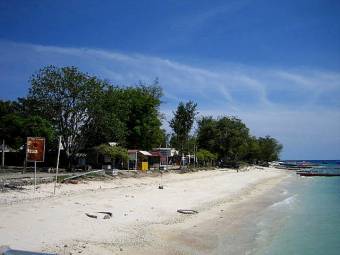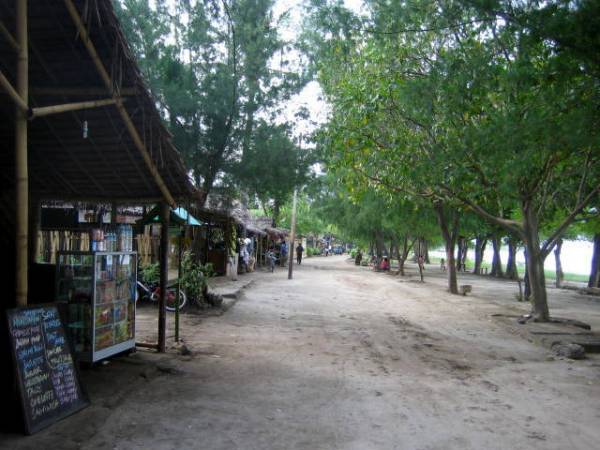Hollin Dickerson
Development along the beach on the conflicted land.Hollin Dickerson |
To visitors, Gili Trawangan appears to be paradise: white sand beaches, clear blue waters and lots of sun. Snorkelers, divers, and beach lovers have flocked here from around the world since the early 1980s to enjoy the peace and quiet of an island where the only modes of transportation are bicycles and horse carts. Just off Lombok’s northwest coast, tiny Gili Trawangan is one of the three Gili Islands, along with Gili Meno and Gili Air. However, unknown to the holiday-goers and even many of the island’s own residents, Gili Trawangan is also the focus of one of Lombok’s longest-running land conflicts. At the heart of the dispute is tension between a government that places tourism at the centre of its development agenda and local residents who feel as though they have been pushed aside to make way for tourism projects. The conflict on Gili Trawangan revolves around local residents’ struggle to gain legal control of land they have lived and worked on for decades. Facing them is a private corporation and the local government that has granted that corporation control over the land despite local residents’ legal opposition and protests.
History of dispute
Prior to the 1970s, Gili Trawangan was unoccupied, except for a brief interlude during World War II when the Japanese interned prisoners of war there. In 1971, the governor of Lombok, Wasita Kusama, decided to establish coconut plantations on the island and gave land rights to two private companies: One hundred hectares in the south were given to PT Rinta, and 100 hectares in the middle were given to PT Generasi Jaya. An additional hundred hectares in the north were set aside for local residents, many of whom had come from Lombok (the Sasak people), others of whom had migrated from Sulawesi in the 1970s in search of farming and fishing opportunities.
Prisoners from Mataram were sent by PT Generasi Jaya to help with its first harvest in 1974, but due to mice, mosquitos and other difficulties, PT Generasi Jaya abandoned the effort and eventually left the land altogether. In 1976, some five families from Lombok grew dissatisfied with the 100 hectares originally set aside for local residents and entered the PT Generasi Jaya land to increase the amount of land available for farming and living. They, as well as the prisoners from Mataram, planted crops such as corn and other vegetables, and constructed houses.
Residents still lack legal title and formal ownership to land they have considered home for decades
By the early 1980s, both PT Rinta and PT Generasi Jaya had decided to give up on their coconut trees, but did so in different ways. PT Rinta went through the proper legal process and released its land to the local subdistrict head of Tanjung. This land was then redistributed to 77 families already residing on it. Today, these owners have legal title to their land, including the structures built upon it.
PT Generasi Jaya, by contrast, abandoned its land. In 1983, the residents who had been living on the land since the mid-1970s made a formal request to the bupati (district head) of West Lombok to gain legal title. According to reports, the bupati did not act on this request, and the West Nusa Tenggara (NTB) provincial government then denied it on the grounds that PT Generasi Jaya had never properly released the land. Today, residents living on this land still lack legal title and formal ownership to land they have considered home for decades.
Tourism begins
 |
For many visitors, Gili Trawangan is a paradise.Hollin Dickerson |
Under President Suharto, Indonesia began promoting tourism as a mainstay of its development agenda. Regional governments, including Lombok’s, followed this lead. At times they promoted tourism projects over local opposition using the Suharto-era system of collusion, corruption and nepotism. Throughout the 1980s, rapid tourism growth on the Gili Islands attracted local government attention; at the same time, the intensifying land conflict on Gili Trawangan threatened to shatter the illusion of a peaceful paradise.
In 1986, the NTB provincial government released PT Generasi Jaya’s right to the land. PT Generasi Jaya then sold this right to another private company, CV Hikmah, and in 1988, CV Hikmah in turn sold the right to the land to PT Gili Trawangan Indah (PT GTI). However, in 1990, the regional land agency declared the former PT Generasi Jaya land to be ‘neglected’, and in 1993 the Governor of NTB cancelled PT GTI’s right to the land. The provincial government then converted the right to the land into a hak pengelolaan lahan (land use right, or HPL), in 1994. An HPL is a right to plan land usage or to use land for specific purposes and is normally awarded for a set period of years. Shortly thereafter, PT GTI signed a Production Contract with the provincial government of NTB, whereby PT GTI agreed to invest capital for the development of the tourism industry on the land in return for the right to the HPL.
This transaction was intensely opposed by Gili Trawangan residents who argued that because PT Generasi Jaya had abandoned its land in the first place, under the law its rights should have been revoked altogether. According to the residents and organisations providing them with legal help, this would have then allowed for the land to be redesignated as state land and redistributed to local residents, as happened after PT Rinta withdrew. Their argument continues that when the regional land agency formally declared the land to be neglected in 1990, the land should have been given to the people. Instead, the provincial government reacted by converting the right to the land into a HPL, which is not recognised by many legal professionals and academics as a valid property right under the 1960 Basic Agrarian Law, and gave that HPL back to PT GTI. As residents point out, the provincial government then quickly signed a Production Contract with the company, which agreed to pay provincial royalties from PT GTI’s tourism buildup.
Residents also argue that the provincial government failed to engage in mutual deliberation and consultations (musyawarah) as required under the 1961 Law on Land Revocations and ignored local adat (customary laws) of the Sasak people regarding land, which stipulate that those who neglect land lose the right to it while those who develop and work land are entitled to it. But residents suspect that local government officials may have been profiting on the side through their dealings with private companies, providing a disincentive for the provincial government to involve the local community in its decision-making process or be transparent about its policies and intentions for the land.
Evictions and raids
Even before the land on Gili Trawangan formally came to be controlled by PT GTI, regional officials had begun trying to evict residents. They first offered compensation, which was rejected by most residents as inadequate. Following this, residents and reports describe three separate raids on the island in 1992, 1993 and 1995. Bungalows, restaurants, tourism-related businesses, and private homes were all destroyed.
Land conflict threatened to shatter the illusion of a peaceful tourist paradise
Although the Production Contract was signed in 1995, PT GTI has yet to build anything. Today, bungalows, restaurants, kiosks, houses and mosques rebuilt since the raids cover the contested land, but residents continue to live in the same legal limbo they have lived in since the 1970s. Without formal title to their land, they face enormous hurdles in improving their standard of living because they cannot use the land as collateral for loans or obtain official credit. And even though residents acknowledge that officials have stated they will no longer conduct raids on the island, the people still live in fear the government could return any day and tear everything down again.
The newly elected village head of Gili Indah (which encompasses Gili Trawangan, Gili Meno, and Gili Air), Taufiq, believes that the ultimate resolution to the conflict will be through political means rather than lawsuits. According to Taufiq, what is needed most are good-faith consultations between the people, the regional government, and PT GTI. However, future negotiations will be difficult due to the high level of mistrust the residents have of the regional government.
Agrarian reform?
Post-Suharto, efforts at significant agrarian reforms at the national level in Indonesia have lagged, although efforts to amend the Basic Agrarian Law in order to strengthen the role of adat laws have made their way to the DPR, Indonesia’s Parliament, and proposals for a special Agrarian Conflicts Resolution Commission have been put forward. What remains to be seen are the effects of the movement toward greater regional autonomy and the corresponding devolution of land and agricultural affairs to local governments. On the one hand, decentralisation could provide opportunities to resolve these conflicts through the local political process. On the other hand, it might give local governments a chance to assert greater authority over local land rights with no national oversight.
The case of Gili Trawangan is only one example of other similar land conflicts in both Lombok and other parts of Indonesia. Throughout the fight on Gili Trawangan, local land owners have remained in a weaker position due to lack of education, money and influence. But the views of Nora, a local community activist, reflect a common sentiment: ‘This land belongs to the community as a whole and we will never stop fighting for it.’ ii
Hollin Dickerson (hollindickerson@gmail.com ) conducted this research while working as an Assistant Policy Analyst for ELSAM in Jakarta and currently works at the U.S. Department of State. The views expressed herein are those of Ms. Dickerson and not necessarily those of the U.S. Department of State or the U.S. Government.
